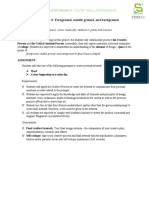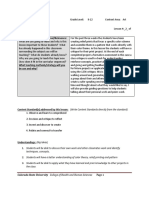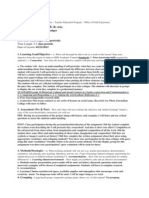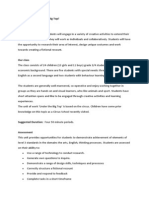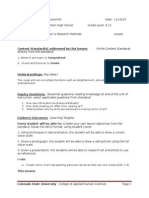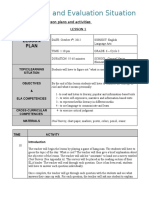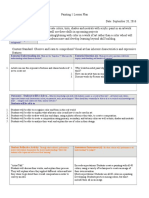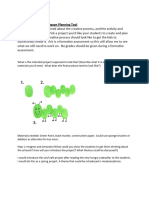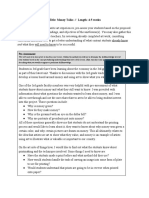Final Plan
Uploaded by
api-280790312Final Plan
Uploaded by
api-280790312Service Learning Lesson Plan
Title:
Lesson 5
Lesson Idea and
Relevance: What are
you going to teach and why
is this lesson of importance
to your students? How is it
relevant to students of this
age and background?
Class/Date: 3/11/2015
We are going to explore the medium of how to use plaster strips in a more
2-dimentional way and explore the textures we can get from it. Then we
will paint it.
Essential Understanding (s): What are the big ideas? What
Essential Question (s): What provocative questions will foster
specific understandings about them are desired?
inquiry, understanding, and transfer of learning?
1. Texture is created through many methods and
mediums.
1. What qualities can texture bring to a piece?
2. Why do we use texture?
2. Finishing a project is just as important as the
project itself.
Outcomes - Students will know...What key knowledge and skills will students acquire as a result of this unit? ...Art history and culture;
expressive features and characteristics of art; art materials, tools, and techniques? What should they eventually be able to do as a result of such
knowledge and skill? ...Compare and contrast art work; analyze sketches?
Students will be able to
Given plaster strips, the student will be able to explore the qualities and limits of this new material
Using the photograph and plaster strips, the student will learn how to create an interesting, less 3-Dimentional work
from a material meant to be 3-Dimentional
Given plaster strips, the student will be able to create textures that replicate the photograph.
Student Reflective Activity: Through what authentic
performance task(s) will students demonstrate the desired
understandings? How will students reflect upon and self-assess their
learning?
We will practice techniques on a separate sheet before
we create anything large. The techniques to be used
will be pinching, twisting, folding, propping up portions
with a paper fill, and then whatever else we can think
up!
Once its dry, this means that she will be able to paint it
as a test also. I will bring in spray paints as well as use
the materials in the studio.
Based on the tests it will make it easier to decide what
to make of the final work. This should take all class.
Assessment Instrument (s):
By what criteria will
performances of understanding be judged?
When she makes the final piece it will be easy to see if
she took the exploration serious. She will most likely
create the forms she enjoyed the most exploring and be
able to build on top of that (example: she enjoys twisting
and has moved on to twisting and pulling upwards to
create a mountainous shape).
Pre-assessment:
How will you help the students know where the unit is going and what is expected? Help the teacher know where the
students are coming from (prior knowledge, interests)?
We discussed what she wanted to make our final day together. When she shows up I will have
a set up for a messy plaster mess with everything prepared for her. We will have a discussion
and I will ask her what she knows about plaster and then we will start from there.
Motivation:
How will you hook all students and hold their interest?
This is something she wanted to learn to do. If she were
to lose interest I will ask her more questions about the
material to help her brainstorm. Things like what
happens if you pull it really tight? Or shove a ball of
newsprint under it? and more things like that that get
her involved and curious to try new things. In the past it
has worked where I will ask her questions like that and
she moves forward excitedly and makes modifications of
what I had suggested.
Ideation:
How will you equip students, help them experience the key
ideas, and explore the issues to generate ideas for their art work?
I will ask questions and work alongside her. Whatever
she does I will also do with a twist or do something
different. I will leave paper and paints out during the
plaster process and see if she becomes interested in
adding to the wet plaster as well as for when its dry. I
will ask her if she wants to hang the plaster on the wall
or what the purpose of it is to make sure she keeps it
more two dimensional.
Procedures:
How is the lesson organized to maximize initial and sustained engagement as well as effective learning? Provide opportunities
to rethink and revise their understandings and work? Allow students to evaluate their work and its implications? Include literacy and numeracy?
Set up everything in a line to show what materials are available
Talk about what it means to make something two dimensional when its material that is 3dimensional
Discuss previous uses and purpose of this artwork
Start by testing ways of moving plaster, stacking, pinching, etc.
Set all tests aside to dry
Create a new and final piece based on the techniques we explored
Set aside to dry hopefully tests are dry by now
Use different types of paints and anything else to cover the work and finish the decoration
Set aside to dry
If the final piece is dry decorate that
If the final piece is not dry make smaller pieces of the plaster to see what other ideas
may be explored
Once piece is dry finish based off the tests done on the test tiles
Materials and Resources: What is needed to complete the learning plan? List materials and resources in a bulleted format.
Plaster strips
Garbage bag
Acrylic/watercolor/spray paint
Paint brushes
Glue
Paper
Newspaper
Water bucket
Towels
Preparation and Safety:
What do you need to prepare for this experience? What safety issues need to be addressed? List steps of
preparation and safety in a bulleted format.
Outside access for spray paint know not to breath it in and spray away from self in
direction of wind
Smock of sorts
Accommodations:
How is the lesson tailored (personalized) to the different needs, interests, and abilities of learners? ...Access (Resources
and/or Process) and Expression (Products and/or Performance)?
She wanted to learn more about the material of plaster strips. She said shes had fun with it in
the past and would like to understand it more.
Understanding the plan...
Stage 1 Desired Results
Relevance - What are you going to teach and why is this lesson of
importance to your students? How is it relevant to students of this age
and background?
Essential Understanding(s) - What are the big ideas? What specific
understandings about them are desired? What misunderstandings are
predictable? (Reflect and Transfer)
Essential Question(s) - What provocative questions will foster inquiry,
understanding, and transfer of learning? (Reflect and Transfer)
Outcomes (objectives): What will students know and be able to do? What
key knowledge and skills will students acquire as a result of this unit?
...Art history and culture; expressive features and characteristics of art;
art materials, tools, and techniques? What should they eventually be able
to do as a result of such knowledge and skill? ...Compare and contrast
art work; analyze sketches? (Comprehend and Create)
Stage 2 Assessment Evidence
Student Reflective Activity: Through what authentic performance task(s)
will students demonstrate the desired understandings? How will students
reflect upon and self-assess their learning? (Comprehend, Reflect,
Create, Transfer)
Teacher-centered Assessment (instrument): By what criteria will
performances of understanding be judged? What evidence (e.g.
quizzes, tests, academic prompts, observations, products/artwork,
sketchbooks, journals, etc.) will students demonstrate achievement of the
desired results?
Stage 3 Learning Plan
W = help the students know where the unit is going and what is expected? Help
the
teacher know where the students are coming from (prior knowledge,
interests)?
(Comprehend)
H = hook all students and hold their interest? (Reflect and Create)
E = equip students, help them experience the key ideas, and explore the issues
to
generate ideas for their artwork? (Create)
R = provide opportunities to rethink and revise their understandings and work?
(Reflect
and Transfer)
E = allow students to evaluate their work and its implications? (Reflect)
T = be tailored (personalized) to the different needs, interests, abilities of
learners
O = be organized to maximize initial and sustained engagement as well as
effective
learning?
You might also like
- ACE III Administration NZ Version A 2014No ratings yetACE III Administration NZ Version A 20146 pages
- Download Complete Counselling Psychology A Textbook for Study and Practice 1st Edition David Murphy Editor PDF for All Chapters100% (3)Download Complete Counselling Psychology A Textbook for Study and Practice 1st Edition David Murphy Editor PDF for All Chapters40 pages
- Service Learning Lesson Plan Title: Abstract Painting/painting With Objects Part 2 Class/Date: 3/4/2015No ratings yetService Learning Lesson Plan Title: Abstract Painting/painting With Objects Part 2 Class/Date: 3/4/20155 pages
- Service Learning Lesson Plan Template 20161No ratings yetService Learning Lesson Plan Template 201614 pages
- Creative Found-Object Drawing Lesson PlanNo ratings yetCreative Found-Object Drawing Lesson Plan3 pages
- Project P3-3 Foreground, Middle Ground, and BackgroundNo ratings yetProject P3-3 Foreground, Middle Ground, and Background9 pages
- Project P3-3 Foreground, Middle Ground, and BackgroundNo ratings yetProject P3-3 Foreground, Middle Ground, and Background7 pages
- Lesson Idea/Topic and Rational/Relevance:: CEP Lesson Plan FormNo ratings yetLesson Idea/Topic and Rational/Relevance:: CEP Lesson Plan Form11 pages
- ARTE PRACTICE Learning Segment Worksheet: (Summative) AssessmentNo ratings yetARTE PRACTICE Learning Segment Worksheet: (Summative) Assessment5 pages
- Lesson Plan # 4 // Title: Clay Functional and Nonfunctional // Length: 3 DaysNo ratings yetLesson Plan # 4 // Title: Clay Functional and Nonfunctional // Length: 3 Days17 pages
- Project P3-6 Light Colours and Dark ColoursNo ratings yetProject P3-6 Light Colours and Dark Colours7 pages
- Learning and Evaluation Situation: Lesson PlanNo ratings yetLearning and Evaluation Situation: Lesson Plan17 pages
- Painting With Color Lesson-Images RemovedNo ratings yetPainting With Color Lesson-Images Removed9 pages
- 3rd Grade Lesson Plan // Title: Money Talks //: Pre-AssessmentNo ratings yet3rd Grade Lesson Plan // Title: Money Talks //: Pre-Assessment20 pages
- Informational Interview With A Clinical PsychologistNo ratings yetInformational Interview With A Clinical Psychologist9 pages
- Carpenter & Westphal (2001) - The Strategic Context of External Network Ties - Examining The Impact of Director Appointments On Board Involvement in Strategic Decision MakingNo ratings yetCarpenter & Westphal (2001) - The Strategic Context of External Network Ties - Examining The Impact of Director Appointments On Board Involvement in Strategic Decision Making6 pages
- Amy-Diamond-Ct807-Media-Analysis-Project-Rubric 2No ratings yetAmy-Diamond-Ct807-Media-Analysis-Project-Rubric 21 page
- Business Studies NotesChapter-6-Motivating-Workers100% (2)Business Studies NotesChapter-6-Motivating-Workers5 pages
- The 4 Secret Traits of Incredibly Lucky PeopleNo ratings yetThe 4 Secret Traits of Incredibly Lucky People10 pages
- Development of The Kalmer Relaxation Intervention Co Design With Stroke Survivors With AphasiaNo ratings yetDevelopment of The Kalmer Relaxation Intervention Co Design With Stroke Survivors With Aphasia14 pages
- The Effect of Sleeping Quality On Cognitive Function Among Senior High Students .1714207743354No ratings yetThe Effect of Sleeping Quality On Cognitive Function Among Senior High Students .171420774335415 pages
- Download Complete Counselling Psychology A Textbook for Study and Practice 1st Edition David Murphy Editor PDF for All ChaptersDownload Complete Counselling Psychology A Textbook for Study and Practice 1st Edition David Murphy Editor PDF for All Chapters
- Service Learning Lesson Plan Title: Abstract Painting/painting With Objects Part 2 Class/Date: 3/4/2015Service Learning Lesson Plan Title: Abstract Painting/painting With Objects Part 2 Class/Date: 3/4/2015
- Project P3-3 Foreground, Middle Ground, and BackgroundProject P3-3 Foreground, Middle Ground, and Background
- Project P3-3 Foreground, Middle Ground, and BackgroundProject P3-3 Foreground, Middle Ground, and Background
- Lesson Idea/Topic and Rational/Relevance:: CEP Lesson Plan FormLesson Idea/Topic and Rational/Relevance:: CEP Lesson Plan Form
- ARTE PRACTICE Learning Segment Worksheet: (Summative) AssessmentARTE PRACTICE Learning Segment Worksheet: (Summative) Assessment
- Lesson Plan # 4 // Title: Clay Functional and Nonfunctional // Length: 3 DaysLesson Plan # 4 // Title: Clay Functional and Nonfunctional // Length: 3 Days
- 3rd Grade Lesson Plan // Title: Money Talks //: Pre-Assessment3rd Grade Lesson Plan // Title: Money Talks //: Pre-Assessment
- All Kinds of Bears: An Integrated Unit for Elementary SchoolFrom EverandAll Kinds of Bears: An Integrated Unit for Elementary School
- Informational Interview With A Clinical PsychologistInformational Interview With A Clinical Psychologist
- Carpenter & Westphal (2001) - The Strategic Context of External Network Ties - Examining The Impact of Director Appointments On Board Involvement in Strategic Decision MakingCarpenter & Westphal (2001) - The Strategic Context of External Network Ties - Examining The Impact of Director Appointments On Board Involvement in Strategic Decision Making
- Business Studies NotesChapter-6-Motivating-WorkersBusiness Studies NotesChapter-6-Motivating-Workers
- Development of The Kalmer Relaxation Intervention Co Design With Stroke Survivors With AphasiaDevelopment of The Kalmer Relaxation Intervention Co Design With Stroke Survivors With Aphasia
- The Effect of Sleeping Quality On Cognitive Function Among Senior High Students .1714207743354The Effect of Sleeping Quality On Cognitive Function Among Senior High Students .1714207743354
















